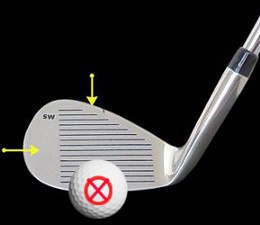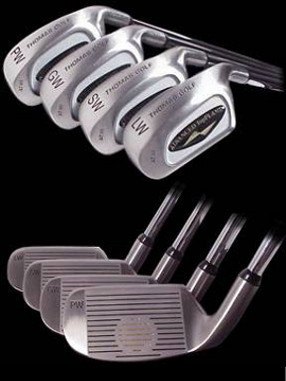
Do you instinctively reach for the sand wedge any time you're in a greenside bunker? If so, you could be costing yourself strokes.
With its loft, typically 56°, and the bounce on its sole, the sand wedge is really designed for shorter sand shots – 50 feet or less, generally speaking – when you need to get the ball up and stop it quickly. For longer bunker shots where there's plenty of green between you and the hole, it's better to take less sand and hit the ball lower, with less spin, so that it rolls forward after landing.
Depending on the length of the shot and the height of the lip you must clear, anything from a gap wedge to an 8-iron might be your best option. In fact, when facing a very low lip with firm sand beneath the ball, some golfers will adopt a chipping style to get the ball out.
Check the bounce on your sand wedge, which should be printed somewhere on the clubhead. A wedge with a high degree of bounce (12-16°) works well from soft sand, but will literally bounce off a compacted surface. If you carry a high-bounce wedge, consider a different club when bunker conditions are firm (after rain, for example). If you need extra height on the shot, simply open your stance and the clubface of your lob wedge, gap or pitching wedge a bit more than usual.
Consider eschewing the sand wedge from a buried lie, too, as the thinner blade of a gap or pitching wedge will slice more cleanly into the sand.
Among experienced golfers, the long bunker shot has a reputation as one of the hardest shots in the game.

In fact, many players would consider it to be the single hardest shot in the game. To successfully execute a long bunker shot, you have to make contact with the sand at exactly the right point. Too close to the ball and you'll send the shot rocketing over the green; too far behind the ball and the shot will never have a chance to get all the way to the target. In other words, you have no margin for error on long bunker shots. You've got to be nearly perfect when playing this kind of shot, and the pressure that goes along with striving for perfection makes it even more difficult to pull this off.
In this article, we are going to attempt to help you improve your performance on long bunker shots. It should be stated right from the start that these kinds of shots will never be easy, even if you improve your skills in this area. It will always be best to simply avoid having to play long bunker shots whenever possible. Course management is a big part of being a good player, and part of your management strategy should be to steer clear of these situations. When they do arise, however, it is important that you have a plan in place.
Before we get into the actual instruction, we should clarify what we mean by 'long bunker shots'. These are not fairway bunker shots, although technically, those are longer than what we are talking about in this article. Rather, we are referring to greenside bunker shots which are played from a relatively long distance away from the hole. Usually, a bunker shot in the range of 25 – 40 yards would fall into this category. You are still in a bunker near the green, but you aren't really able to use the classic explosion shot that you would deploy when closer to the hole. Basically, you are stuck between an explosion shot and a full swing. For every level of golfer, shots played from the sand in this awkward distance range will always be a challenge.
All of the content below is based on a right-handed golfer. If you happen to play left-handed, please take a moment to reverse the directions as necessary.
Evaluating Your Situation

Before you even think about making a swing, you need to first figure out what you are dealing with, and what your options are for the shot at hand. This is going to be a tough shot, but how tough? Remember, you always have options in golf, even if you don't necessarily like all of those options. If playing up toward the hole just doesn't make sense given what you see in front of you, start looking around for other ways to proceed.
To evaluate the difficulty of the long bunker shot you are facing, be sure to check on the following points –
- What does your lie look like? This is where you need to start when trying to plan a long bunker shot. The kind of lie you have in the sand is going to have a lot to say about how well you are going to fare. Ideally, you will have a clean lie on the top of the sand, allowing you to get the club face quite close to the ball at the bottom of the swing. On the other end of the spectrum, you will be in trouble if the ball is sitting down deep in the sand. When that happens, it is hard to pass much energy from the swing to the ball, and the shot is likely to come up short. Since there is nothing you can do about the lie of the ball, you need to accept the reality of the situation. If your lie isn't going to let you play the desired shot, you'll have to adjust and play a more realistic shot out of the trap.
- How far do you need to carry the shot? As you are getting ready to play the ball out of the sand, take a look at the path you need to navigate on the way to the hole. Do you need to carry the ball most of the way to the target, or can you land it short and let it run across the green? It should go without saying that a shot which requires a long carry is going to be more difficult than a shot that allows for plenty of run out. Not only is it harder to execute a shot that carries through the air, but you'll also be taking on more risk. If the shot doesn't work out, the ball will miss the green and you will be quickly adding strokes to your scorecard.
- Will it be easy to get out of the bunker? Your first objective on any bunker shot should simply be to get out of the sand. While it would be great to get up and down in this situation, that isn't always going to work out. It's tough to hit quality shots in this scenario, and even when you do, you'll still have to knock in the putt. You may not get down in two all the time, but you should do everything possible to make sure you get down in no more than three. That means getting your ball out of the trap on the first swing, so you have two more shots to work with. If you take aim at the hole with this shot, is it going to be easy to at least get out of the sand? If not, you may need to change your line of play. Don't take unnecessary risk and wind up leaving the ball in the bunker for an extra shot.
- You don't want to rush into any of the shots you play during a round of golf, and you certainly don't want to rush a shot as difficult as a long bunker shot. Take a moment to look around and evaluate the entire situation to see what opportunities and risks are present. Usually, you will be able to find at least one desirable option for the shot at hand, even if that doesn't mean playing the ball directly at the hole.
It is important to note that you need to brush off any frustration associated with finding yourself in this situation before you make a swing. You'll probably be a little annoyed with yourself that you wound up in this spot, and that frustration may make it hard to focus. Take a moment to gather your thoughts, brush off any negative feelings, and get ready to play the best possible shot.
Picking a Club

In the title of this article, we reference that you should 'look beyond' your sand wedge when dealing with a long bunker shot. In this section, we are going to explain why you would want to consider other options. Yes, your sand wedge has the word 'sand' right there in the name, but that doesn't mean it is the only club in your bag capable of hitting a quality bunker shot.
Below, we have listed a few different club options that you may be able to use on a long bunker shot.
- Gap wedge. If you carry a gap wedge – a club which is between the lofts of your sand wedge and pitching wedge – it may be a great choice for a long bunker shot. With less loft than your sand wedge, you should get a little more carry distance out of this club, yet it still has enough loft to get the ball up and over the lip of most bunkers. As an added bonus, many gap wedges are designed with at least a reasonable amount of bounce on the sole of the club, meaning they can cut through the sand pretty well. Most likely, when you encounter a long greenside bunker shot, the gap wedge is the first club you will turn to for help.
- Pitching wedge. When you don't think the gap wedge is going to offer you enough distance to get the job done, you may need to go down to a pitching wedge. Also, you may need to make this choice if you don't carry a gap wedge at all. There are pros and cons to using your pitching wedge in this situation. On the plus side, you will get significantly more distance and a flatter trajectory than you get with a gap wedge or sand wedge. When trying to blast the ball across the green, the flat shot that a pitching wedge will usually produce is a welcome sight. Not only can this help you carry the ball farther, but the shot may come out with little spin – meaning it can bounce and roll farther toward the target. On the downside, however, is the lack of bounce on the sole of the club. Most pitching wedges have very little bounce, unless you are using a set of irons designed for beginners. Without much bounce to help out through the hitting area, the club may get stuck in the sand. The leading edge will dig in, the club will decelerate quickly, and the shot will never have a chance to reach the target. To pull this shot off successfully, you'll need to execute your swing perfectly. By taking just a little bit of sand as you swing through impact, it is possible to produce a great shot. The margins are thin here, however, so you'll need to be at your best to make it work.
- Lob wedge. Believe it or not, you might be able to handle a long bunker shot by using more loft rather than less. When you need to carry the ball most of the way across a large green, consider opting for your lob wedge. Rather than blasting the ball out of the sand, you are going to try to pick this shot almost clean. You will take just a little sand, but the goal is to hit the ball with the club face, rather than playing the explosion shot that you would usually use. When executed properly, this shot will come out quick and have a lot of spin. Therefore, you can land it up by the hole and use that spin to stop it almost immediately. As you might imagine, this is an advanced shot, and it is going to take some serious skill to pull off. If you are up to the challenge, work on this play in practice and keep it in the back of your mind on the course.
Of course, your club selection doesn't have to be limited to the clubs above (plus the sand wedge). For instance, if you are in a bunker with a particularly low lip – or no real lip at all – you may be able to play a bump-and-run shot with something like a seven- or eight-iron. However, most of the time, the right club for the job is going to be one of your wedges, whether you happen to carry three or four of them. It is important that you are comfortable using all of these clubs out of the sand so you can feel free on the course to pick the right one for the circumstances at hand.






